Cioppino (Fisherman’s Stew)
This post may contain affiliate links. Read my full disclosure policy.
Cioppino, a hearty Italian-American stew made with a medley of fresh seafood in a rich tomato and wine broth, perfectly captures the taste of the sea.
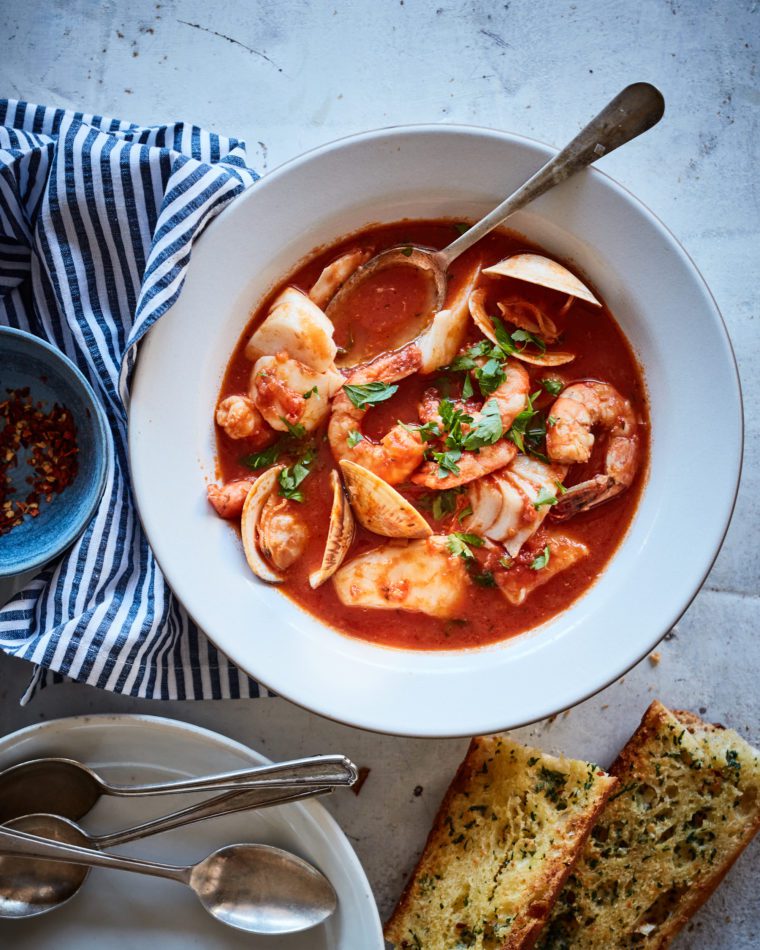
Photo by Johnny Miller, Clarkson Potter 2021
Brimming with fresh seafood in a tomato and wine broth that tastes like the sea, cioppino (pronounced chuh-pee-noh) is a rustic Italian-American fish stew. Its origins can be traced back to Italian immigrant fishermen in San Francisco, but my personal favorite version can be found at Portofino, a picturesque bayside restaurant in Longboat Key, Florida. Every year, my family gathers at Portofino over the holidays to enjoy the cioppino, and the chef was kind enough to share his recipe with me.
To make the recipe more accessible for home cooks, I have modified it by using fewer types of seafood (though crab, lobster, or mussels would all make wonderful additions). To fully enjoy this wonderful stew, serve it with garlic bread, focaccia, or a baguette to soak up the flavorful broth—and be sure to set out an extra bowl for shells and plenty of napkins.
Table of Contents
“I’m a culinary trained chef of 25 years working on private yachts now…All I can say is wow!!!! The broth is spot on.”
What You’ll Need To Make Cioppino
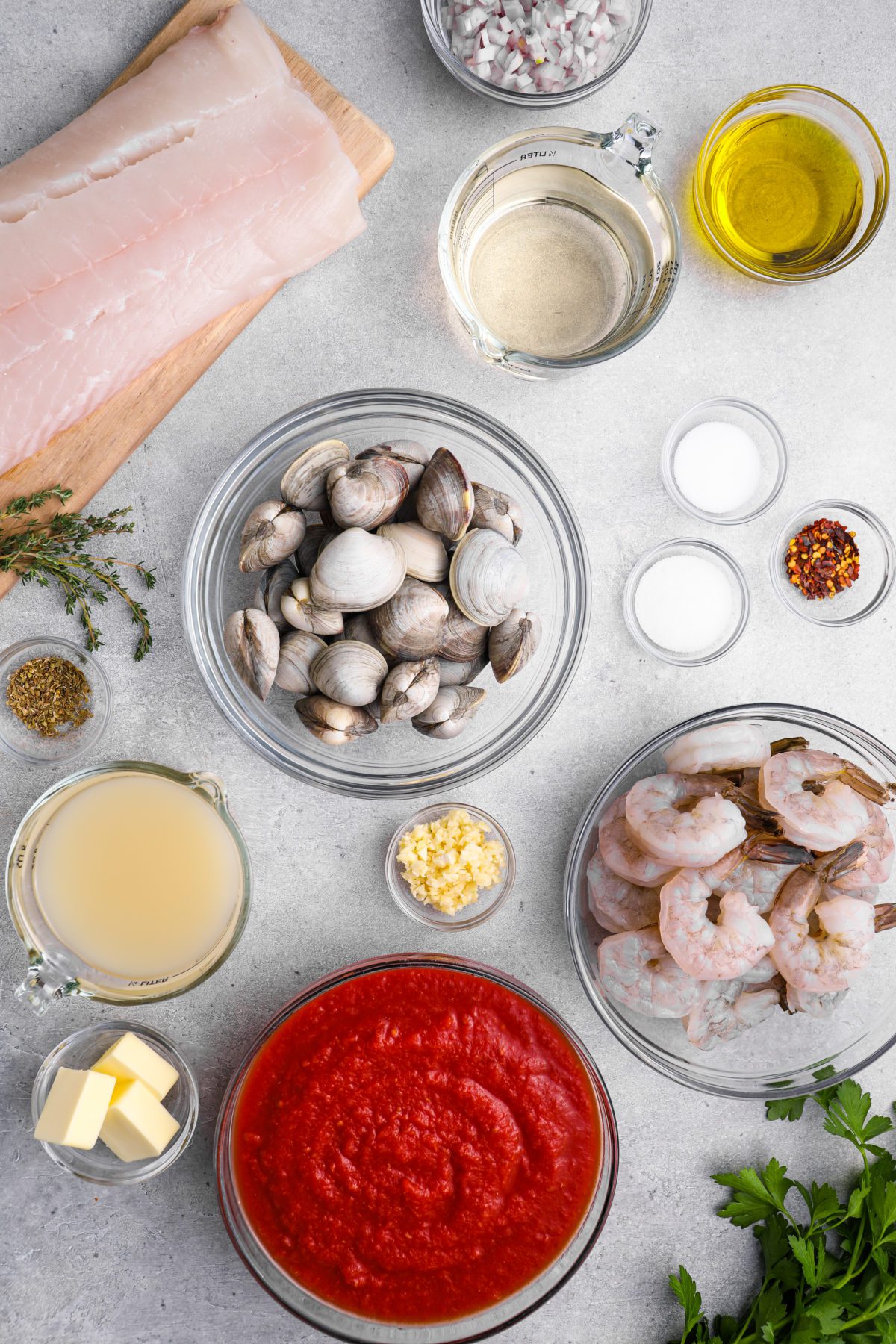
- Shallots and Garlic: These aromatics form the flavor foundation for the stew.
- White Wine: Adds acidity and brightness, complementing the seafood.
- Canned Crushed Tomatoes: Gives the cioppino its rich tangy flavor and vibrant color.
- Clam Juice: Lends a briny depth that makes cioppino truly taste like the sea.
- Crushed Red Pepper Flakes, Oregano, Thyme: This combination of spices and herbs adds warmth, earthiness, and a hint of heat.
- Firm-fleshed Fish Fillets: Chunks of halibut, cod, salmon, or snapper absorb the broth’s savory broth and contribute their own delicate taste to the stew.
- Butter: Added at the end of the cooking process to give the cioppino and a velvety finish and round out the acidity of the wine and tomatoes.
- Littleneck Clams: A traditional cioppino ingredient, the clams open up during cooking to release their sweet, briny juices into the broth. (See the FAQs for how to store and clean them.)
- Shrimp: With their slightly sweet, meaty texture, shrimp cook quickly and absorb the surrounding flavors.
- Jump to the printable recipe for precise measurements
Step-by-Step Instructions
To cook the stew, heat 1/4 cup of the oil over medium heat. Add the shallots and cook until soft and translucent, about 5 minutes. Add the garlic and for 1 minute more. Do not brown.
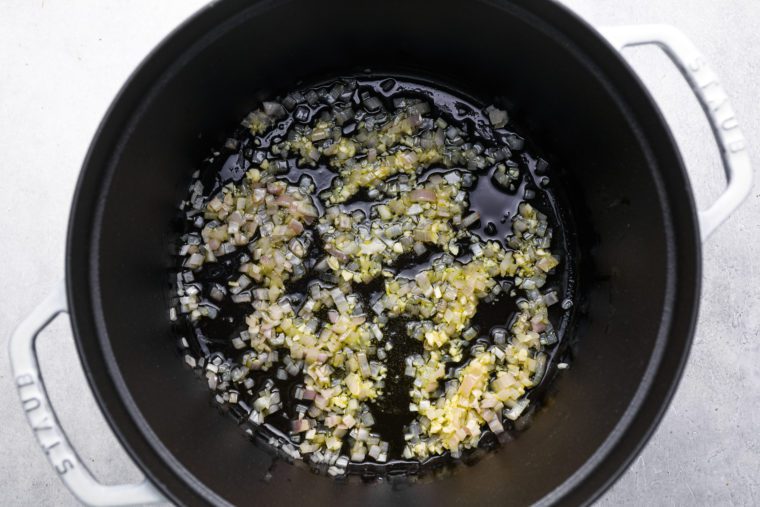
Add the wine and increase the heat to high. Boil until the wine is reduced by about half, 3 to 4 minutes.
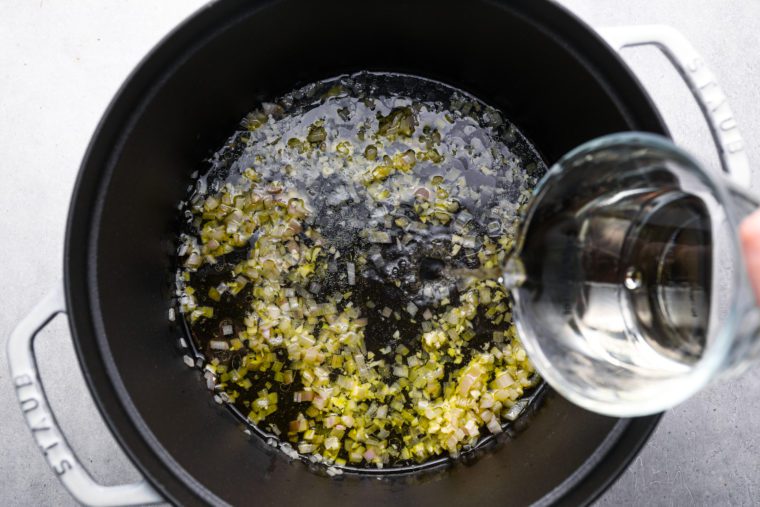
Add the crushed tomatoes, clam juice, sugar, 1 teaspoon of the salt, red pepper flakes, oregano, thyme sprigs, and 1 cup of water. Bring to a boil; reduce the heat and simmer, covered, for 25 minutes.
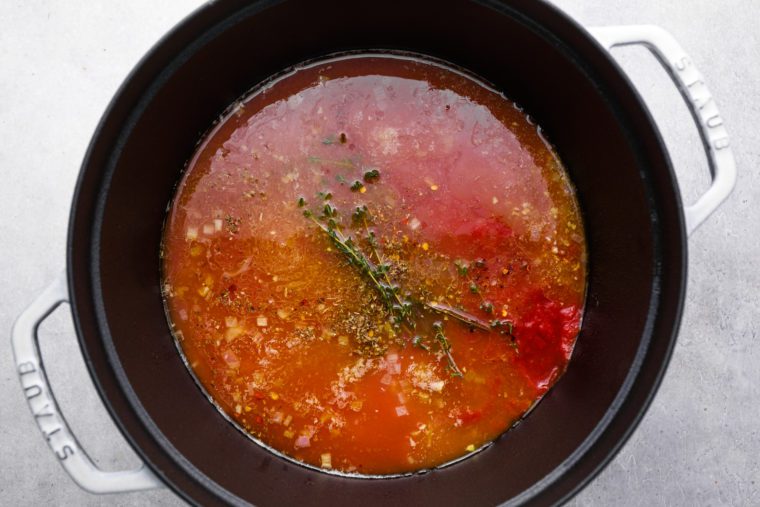
Meanwhile, while the stew is simmering, toss the fish with the remaining 2 tablespoons oil and remaining 3/4 teaspoon salt. Arrange the fish on the prepared baking sheet.
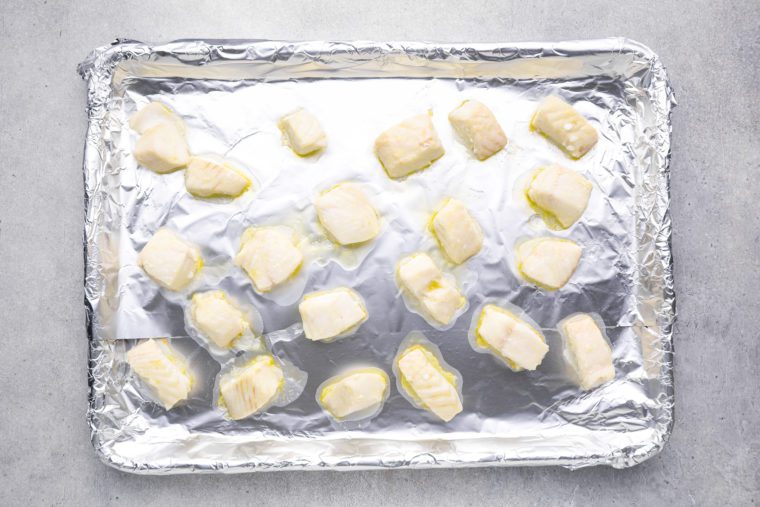
Bake for about 10 minutes at 400°F, or until just cooked through. Cover and keep warm until ready to serve. (Note: most cioppino recipes call for the fish to be simmered in the broth but I prefer to bake it separately so that it doesn’t fall apart or overcook.)
When the stew is done simmering, remove and discard the thyme sprigs and stir in the butter.
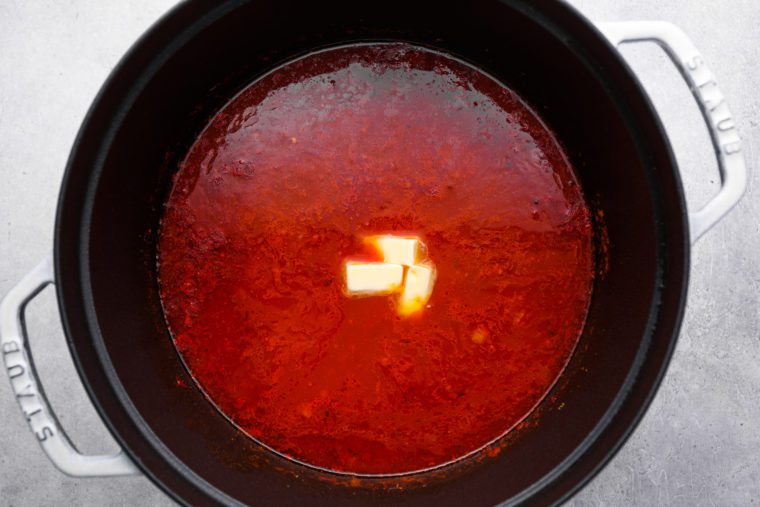
Add the clams and bring the stew back to a simmer.
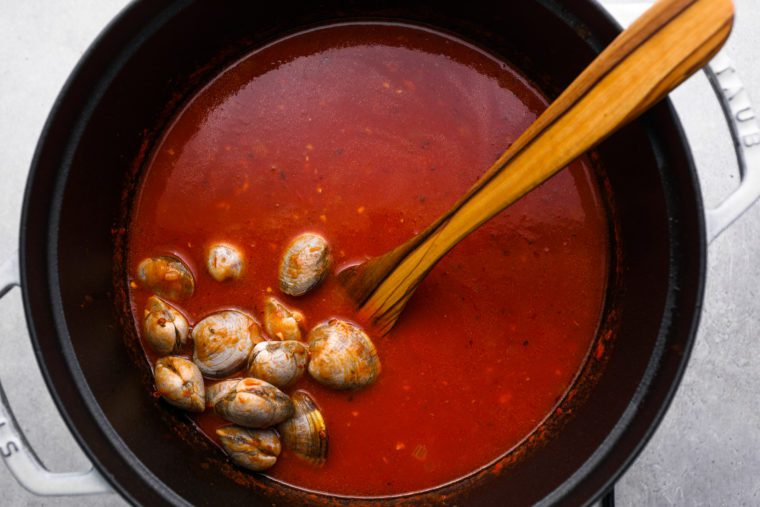
Cover and cook for about 6 minutes, until the clams have mostly opened. Gently stir in the shrimp and bring the stew back to a simmer.
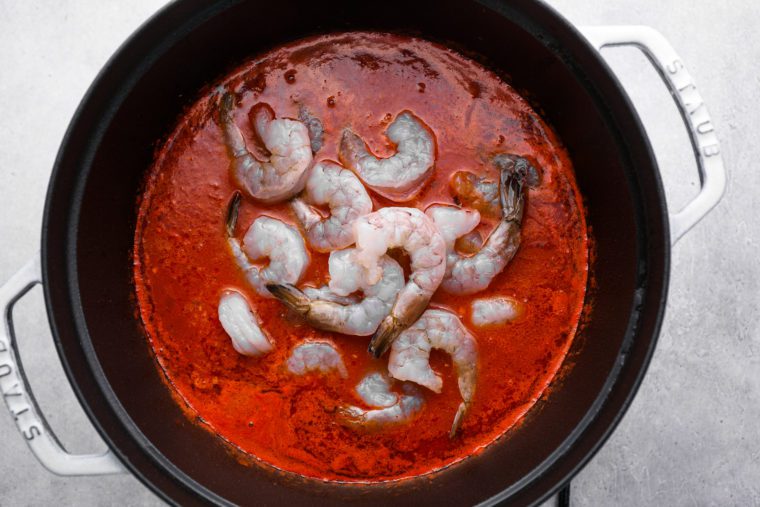
Cover and cook until the shrimp are just cooked through and the clams are completely opened, about 5 minutes. Discard any unopened clams. Add the chopped thyme, then taste the stew and adjust seasoning, if necessary.
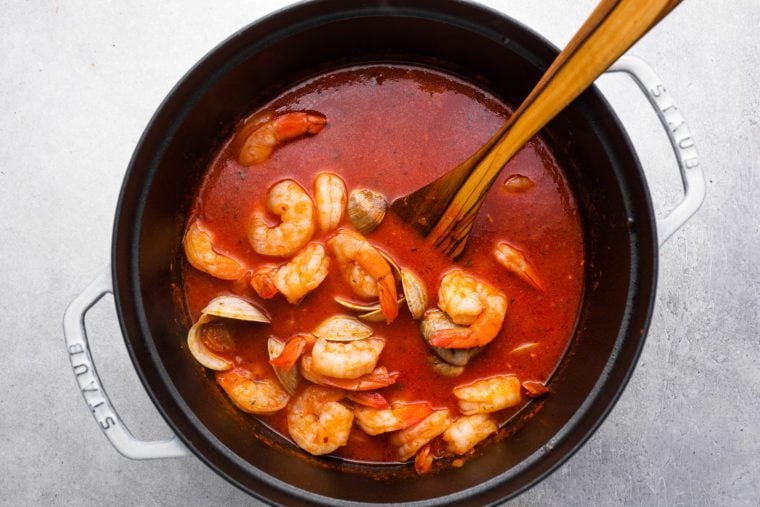
Divide the warm fish into serving bowls. Ladle the stew over top, dividing the clams and shrimp evenly amongst the bowls. Garnish with parsley, if using, and serve with garlic bread, focaccia, or a baguette for sopping up the broth.
Frequently Asked Questions
First, make sure all of the shells are tightly closed. If any clams are open, gently tap them against the countertop; if they are alive, they will close their shells. Discard any clams that do not close their shells or that have cracked or chipped shells.
Before cooking the stew, place the clams in a bowl and cover them with cool tap water. Let them sit for 20 minutes to an hour. During this time, the clams will expel sand from inside their shells. When you’re ready to cook, lift each clam from the water and rinse it, scrubbing if necessary, to get rid of any grit from the surface. (Note that most supermarkets sell farm-raised clams, which are already quite clean, so you may not find a lot of grit or sand.)
Clams are usually sold in a mesh bag because they are alive and need to breathe. If your fishmonger places them in a plastic bag, remove them from the bag immediately when you get home from the supermarket and place them in a bowl covered with a damp cloth in the refrigerator.
You can make the cioppino, without the seafood, up to 2 days ahead of time. Store it in the refrigerator, covered. When ready to serve, bake the fish and bring the stew to a simmer before adding the seafood.

Video Tutorial
You May Also Like
Cioppino (Fisherman's Stew)
Cioppino, a hearty Italian-American stew made with a medley of fresh seafood in a rich tomato and wine broth, perfectly captures the taste of the sea.
Ingredients
- ¼ cup + 2 tablespoons extra-virgin olive oil, divided
- ⅔ cup finely chopped shallots, from about 3 shallots
- 3 cloves garlic, minced
- 1 cup white wine
- 1 (28 oz) can crushed tomatoes
- 2 (8 oz) bottles clam juice
- 2 teaspoons sugar
- 1¾ teaspoons salt, divided
- ½ teaspoon crushed red pepper flakes
- ½ teaspoon dried oregano
- 7 sprigs fresh thyme, plus 1 teaspoon fresh chopped thyme
- 1½ pounds firm-fleshed fish fillets, such as halibut, cod, salmon, snapper, etc., cut into 2-inch pieces
- 3 tablespoons unsalted butter
- 1½ pounds (about 18) littleneck clams, scrubbed (see note)
- 1½ pounds extra large raw shrimp, peeled and deveined
- Fresh chopped Italian parsley, for garnish (optional)
Instructions
- Preheat the oven to 400°F and set an oven rack in the middle position. Line a baking sheet with aluminum foil and set aside.
- In a large pot, heat ¼ cup of the oil over medium heat. Add the shallots and cook, stirring frequently, until soft and translucent, about 5 minutes. Add the garlic and cook, stirring constantly, for 1 minute more. Do not brown.
- Add the wine and increase the heat to high. Boil until the wine is reduced by about half, 3 to 4 minutes.
- Add the crushed tomatoes, clam juice, sugar, 1 teaspoon of the salt, red pepper flakes, oregano, thyme sprigs, and 1 cup of water. Bring to a boil; reduce the heat and simmer, covered, for 25 minutes.
- Meanwhile, while the stew is simmering, toss the fish with the remaining 2 tablespoons oil and remaining ¾ teaspoon salt. Arrange the fish on the prepared baking sheet and bake for about 10 minutes, or until just cooked through. Cover and keep warm until ready to serve.
- When the stew is done simmering, remove and discard the thyme sprigs and stir in the butter. Add the clams and bring the stew back to a simmer. Cover and cook for about 6 minutes, until the clams have mostly opened. Gently stir in the shrimp and bring the stew back to a simmer; cover and cook until the shrimp are just cooked through and the clams are completely opened, about 5 minutes. Discard any unopened clams. Add the chopped thyme, then taste the stew and adjust seasoning, if necessary.
- Divide the warm fish into serving bowls. Ladle the stew over top, dividing the clams and shrimp evenly amongst the bowls. Garnish with parsley, if using, and serve with garlic bread, focaccia, or a baguette for sopping up the broth. Set out a second bowl for shells and plenty of napkins.
- Make Ahead: The stew, without seafood, can be made 2 days ahead and stored in the refrigerator, covered. When ready to serve, bake the fish and bring the stew to a simmer before adding the seafood.
- Note: Littleneck clams are readily available at most supermarkets and are usually sold in a mesh bag because they are alive and need to breathe. If your fishmonger places them in a plastic bag, remove them from the bag immediately when you get home from the supermarket and place them in a bowl covered with a damp cloth in the refrigerator. To prepare the clams for cooking, first, check that they are alive by making sure all of the shells are tightly closed. If any clams are open, gently tap them against the countertop; if they are alive, they will close their shells. Discard any clams that do not close their shells or that have cracked or chipped shells. To clean, place all of the clams in a bowl and cover them with cool tap water. Let the clams sit for 20 minutes to an hour. During this time, the clams will expel sand from inside their shells. When you’re ready to cook, lift each clam from the water and rinse it, scrubbing if necessary, to get rid of any grit from the surface. (Note that most supermarkets sell farm-raised clams, which are already quite clean, so you may not find a lot of grit or sand.)
Pair with
Nutrition Information
Powered by ![]()
- Per serving (6 servings)
- Calories: 575
- Fat: 23 g
- Saturated fat: 6 g
- Carbohydrates: 20 g
- Sugar: 9 g
- Fiber: 4 g
- Protein: 69 g
- Sodium: 1,650 mg
- Cholesterol: 287 mg
This website is written and produced for informational purposes only. I am not a certified nutritionist and the nutritional data on this site has not been evaluated or approved by a nutritionist or the Food and Drug Administration. Nutritional information is offered as a courtesy and should not be construed as a guarantee. The data is calculated through an online nutritional calculator, Edamam.com. Although I do my best to provide accurate nutritional information, these figures should be considered estimates only. Varying factors such as product types or brands purchased, natural fluctuations in fresh produce, and the way ingredients are processed change the effective nutritional information in any given recipe. Furthermore, different online calculators provide different results depending on their own nutrition fact sources and algorithms. To obtain the most accurate nutritional information in a given recipe, you should calculate the nutritional information with the actual ingredients used in your recipe, using your preferred nutrition calculator.

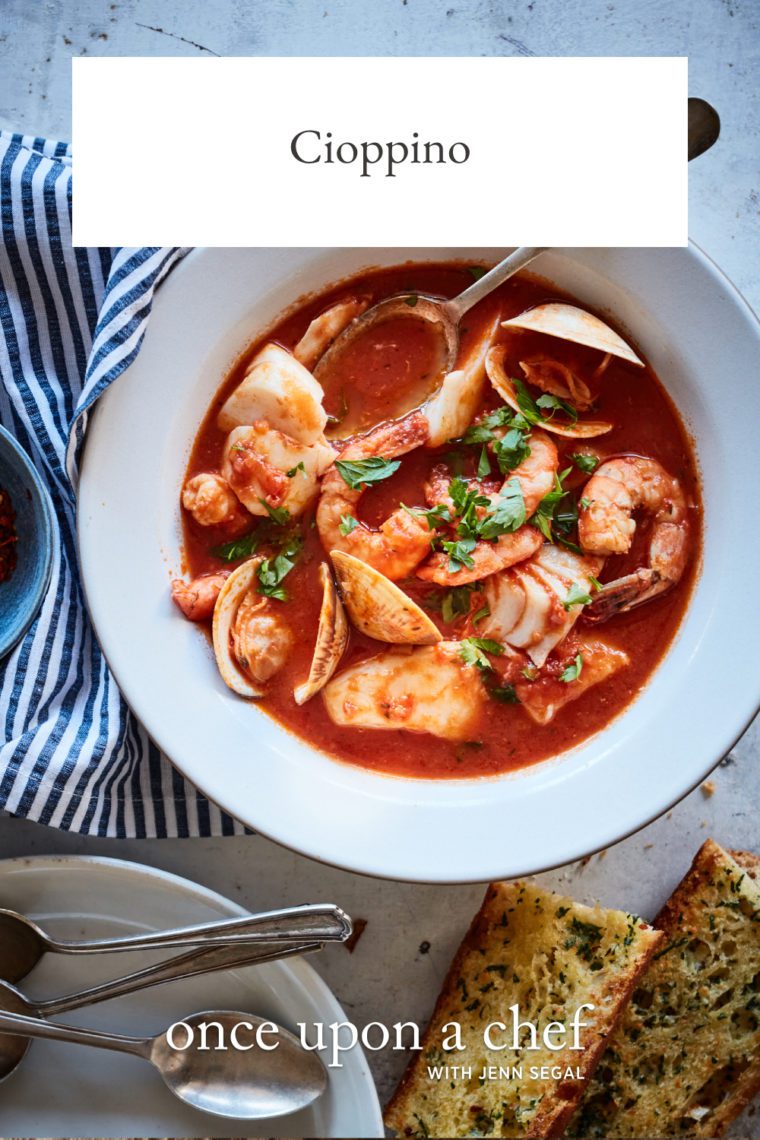
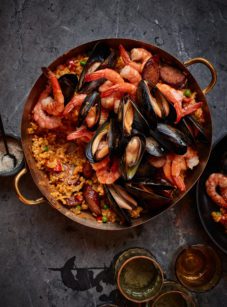
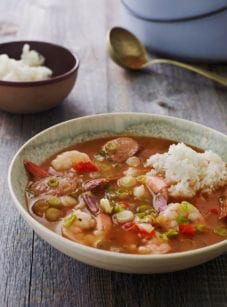
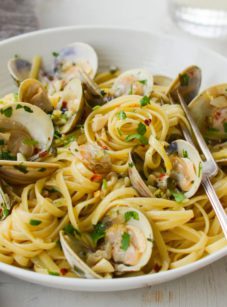
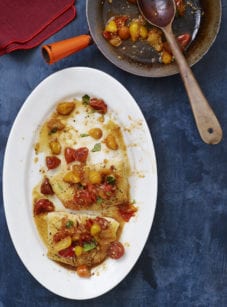

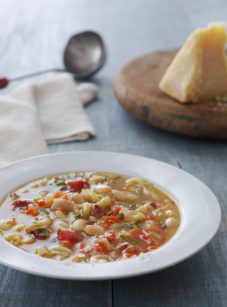
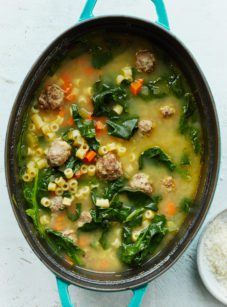
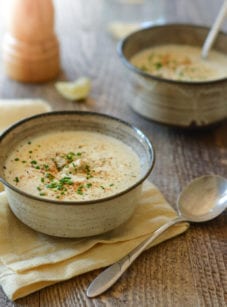
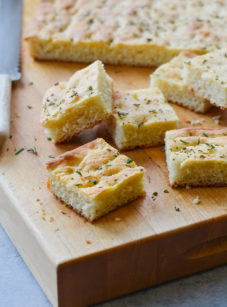
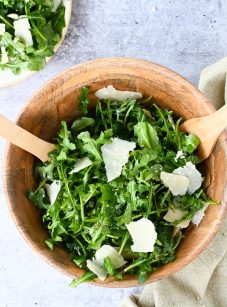
Hey Jenn, the stores around me are all out of fresh thyme. Do you think this would work with dried thyme?
Sure, I think you could get away with dried thyme here and I’d recommend about 1 teaspoon. Please LMK how it turns out!
Thank you so much for your response! My husband actually found some fresh thyme, and it came out delicious as always. I really appreciate your advice and all the recipes you share with us on your site and in your book.
Hi Jenn,
Thank you for your reply re: the timing of cooking the firm-fleshed fish and shellfish in the broth rather than oven baking the fish separately. I always love your very thorough responses for us novice cooks! I “winged” the timing, monitoring the process very carefully, and found that the firm -fleshed dish did indeed take about 6 minutes, but the shellfish actually took closer to 10(?!) Everything was absolutely delicious, but in view of your thoughts that the shellfish should not take more than just a few minutes, I wonder if I did something wrong? We followed the rest of the recipe exactly, but my husband said the temperature of the dish could have been a little hotter, and he thinks I cook with too low a fire? I had the pot on simmer, but when initially sautéing the shallots, the hot oil splattered so much on my skin that I got skittish and kept the fire down. Should I have put the pot (5 qt Le Creuset) on a smaller burner, with less btu power and turned up the fire instead? The shrimp were not rubbery at all, but I would like to get the meal to a little hotter temp ( I have a new Wolf stovetop, and your timing suggestions have always been spot on!) Also, the leftovers next day were actually even better, the fish more infused with flavor and tender, and the broth a little creamier!
Thanks for any suggestions!
Elise
Hi Elise, I think turning up the heat a bit would be beneficial – – not only will it make the shellfish cook more quickly but it will get the finished dish to be a little hotter. Hope that helps!
I made this dish for Valentine’s day. I used 3 different types of fish instead of 1 + shellfish because of allergies. Other than that, I followed it exactly. So good and it felt special, too. Will definitely serve with garlic bread next time!
Hi Jenn,
I would like to make this dish tonite, with cod, halibut, shrimp and scallops, ( no clams ), and simmering the fish in the broth, not first baking in the oven. At what point, and for how long, would I add the firm fleshed fish, and would I cover pot at all, and when would I drop the shrimp and scallops, and for how long? Thank you!
Elise
Hi Elise, I’m so sorry I think I’m probably too late to reply, but I would give the fish 5 to 10 minutes, depending on how thick, and I would cover the pot. The shellfish would need 2 to 4 minutes.
This recipe is amazing! If you are looking to impress someone this is the dish. I made it for my husband’s birthday as this is something that he will order when we go out on occasion. The flavor was incredible. We all truly enjoyed it. It is definitely something we will make again. Thank you!
I made Jenn’s Cioppino for my family this evening, and it was as good or better than any I’ve ever had in a restaurant. The recipe, as with all of Jenn’s recipes, was very well-written and easy to follow. I used a combination of cod and haddock, and also added some scallops along with the shrimp and clams. The only modification I made was to add a half of a vidalia onion, which I sauteed with the shallots. Also, I didn’t bake the fish ahead of time; I cooked it directly in the stew and it wasn’t a problem even if some of the fish did fall apart. It was all delicious and my family loved it. Thanks, Jenn, for another great recipe.
Wonderful and surprisingly easy!
Between this site and your beautiful cookbook I’m trying new recipes several times a week. Everything has been a hit 🙂
Hi Jen:
My husband only likes certain seafood, wondering if I could eliminate the clam juice? I am worried it might be too “fishy” for him? Thanks.
Hi Margarita, I suspect you could get away with replacing the clam juice with vegetable broth. Please LMK how it turns out if you try it! 🙂
I made this recipe last winter and it turned out fantastic. You are right in saying some other seafood makes a great addition, I added mussels and King Crab. I really like your recipes, they always turn out well for me. I’m a senior Perfumer for a global co., if you ever want a cologne or perfume, I’m your Huckleberry!
Best regards, Rich Nero
Hi Jenn, thank you for this great recipe. I halved it and made it for dinner tonight! My husband and I enjoyed this very much. xx
Hi Jen, Do you think I would be able to use scallops instead of the halibut or cod? And if so, should I bake the scallops first?
P.S. You are the first person I go to when I am looking for a delicious new recipe! Love them all!
So glad my blog is your go-to! Yes, you could use scallops here – I’d cook them first and add at the end to be 100% sure they don’t overcook. Hope you enjoy!